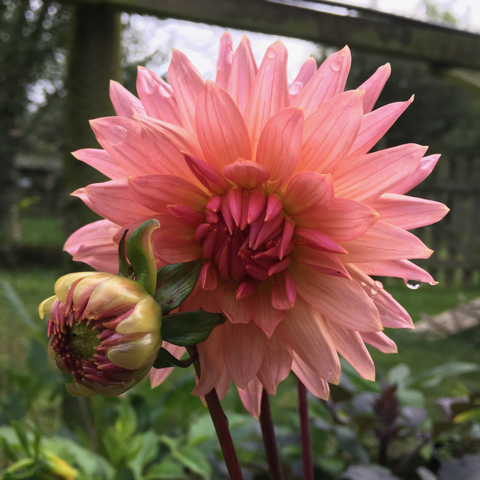Summer is in full glory in July, there is never a moment to sit still! Vegetable patches are heaving with the weight of ripening produce, as are fruit bushes, strawberry plants, tomatoes in the greenhouse and potato plants, although the latter are doing it a little more quietly underground.
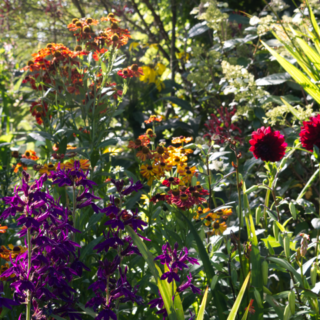 Flower gardens are full of colour and buzzing insects, and if you’re the type of gardener like me, who tries to sit in the sun for five minutes but spies something that needs attention, you will never stop.
Flower gardens are full of colour and buzzing insects, and if you’re the type of gardener like me, who tries to sit in the sun for five minutes but spies something that needs attention, you will never stop.
The key for July is water! Recently it does seem that by July our weather has hit early autumn so we no longer get those long, baking summer weeks we used to, where the grass went brown and borders began to lose their colours.
But if it doesn’t rain for a few days, it is warm enough for vegetables and newly-planted plants to dry out very quickly so do keep watering them. Pots will need regular watering too, as when it rains the dense foliage will prevent water reaching the soil for a good soak.
Curiously though, we are seeing more problems with shrubs and trees than we used to during those hot summers. The ‘hive mind’ of professional gardeners (i.e. discussions we’ve been having on social media) is thinking it could be related to having hot, dry periods early in the year now, in March, April or May. Certainly I am seeing more and more trees starting to die off at the tips and top branches, any leaves produced are lower down and smaller than usual. Most likely due to a lack of water at the time the plants are trying to produce new leaves in the spring.
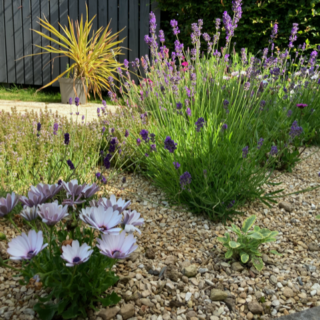 Another thought on our upside-down water delivery system (a.k.a. the weather) is to create free-draining, more drought-tolerant gardens. Initially we might need to add gravel as few gardens will be naturally free-draining, so the sustainability is questionable, but it will require less water for many years to come.
Another thought on our upside-down water delivery system (a.k.a. the weather) is to create free-draining, more drought-tolerant gardens. Initially we might need to add gravel as few gardens will be naturally free-draining, so the sustainability is questionable, but it will require less water for many years to come.
If you lose a plant due to environmental conditions, don’t replace it with the same, unless there are varieties that are more tolerant. Have a look at Beth Chatto’s work over the years and the garden and nursery her granddaughter now runs, for ideas on gardening with less water. (And in case you were thinking about all the rain we get, that’s where the free-draining aspect comes in!).
Trees and shrubs
Time for the summer apple prune, which can take place any time in July or August. Pruning fruit trees can seem complicated, and it’s true that each needs slightly different care, but in the summer, trimming an apple tree will help the sun reach the fruit so it ripens better. If you haven’t thinned the fruit to two per spur by now, do this while you’re pruning.
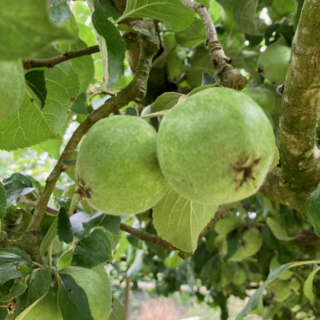 A mature, well-shaped apple or pear tree may not need any pruning in the summer. However, if your tree has many bolt-upright new shoots growing from horizontal branches (water shoots) then these should be removed now, and again later if it produces any more. They are usually formed in response to a hard prune at some point. Cut these off right at the bottom by the branc
A mature, well-shaped apple or pear tree may not need any pruning in the summer. However, if your tree has many bolt-upright new shoots growing from horizontal branches (water shoots) then these should be removed now, and again later if it produces any more. They are usually formed in response to a hard prune at some point. Cut these off right at the bottom by the branc
If you want to restrict the size of a mature tree, prune each ‘leader’ shoot on the end of branches back by one half of the new growth. Cut the new side shoots back to just two or three nodes to encourage formation of fruiting spurs. Don’t cut in to woody growth at this time of year.
If you need to shape your trained tree such as espalier, stepover or fan, you will need to give it a trim now. This is the same for pears.
Identify shoots that are this year’s growth. Cut these back to within 2-4 leaves of last year’s wood, cutting just above a leaf node. For shoots which have grown on last year’s laterals, cut these back to one leaf.
Cut all this year’s shoots, apart from any that you need to extend the shape of the tree. Tie these in to the framework.
Carry out all pruning of stone fruits in July and August too, choosing a dry few days if possible. Cherries, damsons, apricots, peach etc. can all have formative (structural) or light pruning during the summer.
You might notice your wisteria is making a bid for freedom this month (as does our passion flower, usually up and along the telephone wire), producing a lot of long whippy growth. Cut this off to within 4-6 leaves to keep it under control and persuade it to produce more flower buds rather than trying to escape. If you think we may still get lucky with the weather and have some more summer before the end of August, the wisteria can easily be left until then so it does not make a second bid for freedom in the warmth.
You can continue pruning topiary and evergreen shrubs and hedges. Reducing the leaf quantity will also help the plants in dry weather as it will reduce the amount of water the plants need.
Herbaceous borders
First of all, the lawn. The foil which sets off the herbaceous border in all its summer glory. Cut it on a higher setting during the (possibly) drier months of summer. Leaving it a little longer will enable it to handle drought more effectively.
Keep deadheading religiously, your plants will keep flowering on and on and you will be rewarded for it. Especially sweet peas, which will sulk if you stop paying attention to them and picking the flowers regularly for sweet-scented displays!
If there are any gaps it’s not too late to find some summer bedding at the garden centre to fill in the spaces. Remember to water them in really well.
 Keep adding in plant supports as the summer flowers grow, especially for those with large, heavy flowers such as dahlias. One day of rain and they could all be weighted right down to the ground.
Keep adding in plant supports as the summer flowers grow, especially for those with large, heavy flowers such as dahlias. One day of rain and they could all be weighted right down to the ground.
Feed all pots regularly. Bedding, perennials, roses, fruit, trees, anything in a pot will need food at least once a fortnight during the summer.
Start sowing biennials such as foxgloves, echiums, honesty and wallflowers. Although in my garden I find that if I leave my wallflowers in place, they either survive and come back for another year, albeit a bit leggy, or they seed where they are so I don’t have to bother with trays and pots! The rest of the herbaceous border hides them as they look scruffy.
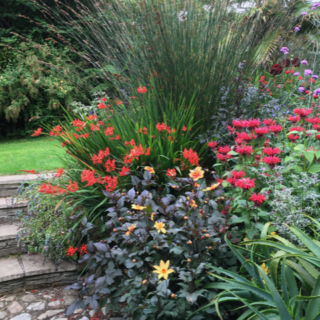 If you do ever get a chance to sit down or at least wander around with a cup of coffee, have a look at what it working and what isn’t, and plan changes to be made in the autumn or spring.
If you do ever get a chance to sit down or at least wander around with a cup of coffee, have a look at what it working and what isn’t, and plan changes to be made in the autumn or spring.
The productive garden
The key for the veg patch is harvesting! Keep picking courgettes (or you will have marrows in a couple of days), beans, peas, salad leaves, tomatoes and even soft fruit as the more you pick, the more the plant could produce.
There could be rather too much to deal with at the moment, with potatoes, onions, garlic, beetroot and carrots all ready for collecting as well.
And while you are there every day gathering the bounty, have a thought about sowing seeds for the next round of produce – spring cabbage, turnips, fennel, pak choi and winter salads. You can also make further sowings of carrots, radishes and beans.
Keep pulling the weeds to remove any competition for water at this time of year, and do provide water if necessary. However, hopefully a good dose of organic material last winter will have reduced the need for water. You can also grow your crops ‘hard’, without watering them once they are established. It is a risk, some may object, but some may do alright, although the crops may be smaller – they may also be more tasty!

Caroline Kenzie
Papaver Garden Design and Tuition (link to go on this text)

